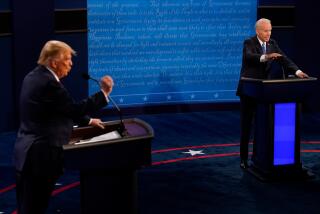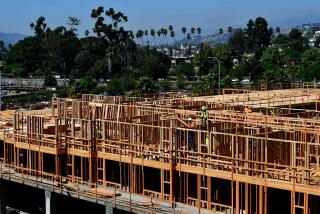Chiapas Massacre Has Many Fathers
There is more than enough blame to go around--and few enough individuals or institutions willing to share it--for the massacre in Chiapas just before Christmas. The murder of 45 villagers, including women and children, by a large, well-organized and well-armed group of masked men, has justifiably shocked Mexico. It has also highlighted the consequences of reckless behavior on the part of many people, from the federal, state and local authorities to the rebels themselves.
It would be unfair and inaccurate to place direct, immediate responsibility for the massacre on the PRI (Institutional Revolutionary Party) as a whole or the Zedillo administration in particular. But it is true that the government, by its neglect of the situation in Chiapas and its mistaken decisions, bears much of the blame for the horror that occurred in the village of Acteal.
Zedillo and his Cabinet had decided, cynically but correctly, that the military struggle with the Zapatista National Liberation Army (EZLN) in early January 1994 was virtually over before it started. The Zapatistas had no weapons, no ammunition and no real desire to sacrifice myriad lives and entire communities in unequal combat. From this premise the government concluded that the negotiations with the Zapatistas could be allowed to drag on endlessly. In 1996, the negotiators proposed and Zedillo rejected the so-called San Andres Larrainzar agreements, which, among other points, foresaw the creation of autonomous indigenous villages in Chiapas.
It was true that nothing really would happen, in terms of an armed confrontation with the EZLN, if a formal peace was not signed and ratified. It was also, sadly, true that public opinion--domestic and international--could prevent the government from putting down the rebellion militarily but could not muster enough active, solid support for the Zapatistas’ cause or their demands. Where Zedillo committed a serious mistake was in believing that this deadlock insured that there would be no outbreaks of nonmilitary violence in Chiapas. His administration subordinated the various local tensions--between PRI-istas and Zapatistas, between landowners and landless peasants, between different ethnic groups within the Indian population, between Catholics and evangelicals--to the purely political-military conflict with the EZLN. Left to fester, these interior antagonisms were bound to draw blood, which is what happened in the municipality of Chenalho on Dec. 22.
A second dose of responsibility must be borne by the federal authorities for tolerating (at best) or abetting an atmosphere of hostility, expressed in acts ranging from harassment to revenge, on the part of the broader Chiapas community against the Zapatistas and their sympathizers. The Zedillo government seriously underestimated or deliberately ignored the risks that parochial antagonisms would bring to the post-insurrection climate of pretended truce. Zedillo did not have to tell anyone to go and shoot the villagers, nor did Minister of the Interior Emilio Chuayffet, despite his outrageous insistence on saving his job. Even the inept governor of Chiapas, Julio Cesar Ruiz Ferro, already accused of negligence by Zedillo-appointed Human Rights Commissioner Mirella Rocatti, surely did not instruct anyone to hunt down and massacre women and children. But underlings in Mexico have always been known to interpret their masters’ wishes in a peculiar fashion: If ordered to dissuade a group, they will frighten it; if instructed to scare it, they will commit a minor act of aggression; if given the impression that they should go further, they will go very far indeed.
The responsibility for the Acteal tragedy lies not only with the government, however. Subcommander Marcos and the other Zapatista organizers quite reasonably have imbued the indigenous communities in the highlands of Chiapas with mistrust of and resistance to the PRI-dominated, cacique-subservient, white, corrupt and authoritarian political and economic system that has exploited them for decades. The evil, abusive, racist nature attributed by Marcos and others to the system was accurate enough. But the Zapatistas are now discovering that the “bad guys” are actually very bad, an experience that parallels those of the Guatemalan guerrillas in the early 1980s and the Salvadoran ones in the late 1970s. Both groups’ leaderships disregarded their judgment of their governments’ capacity for ruthlessness and dispatched thousands of peasants, workers and students to rise up in revolution--and then were surprised when the vicious dictatorships fought back. Worse, the rebel leaders found that they could not defend their sympathizers against death squads and army offensives. Some analysts and former rebels now say that the Central American revolutionaries actually sent the masses to the slaughterhouse, hoping to capitalize on the international and local reaction; others, less suspicious of the guerrillas’ intentions, simply fault them for recklessness and incompetence.
What is hard to disguise in Chiapas is that Marcos and the Zapatista high command never had the ability to defend their sympathizers, either in their own communities or, once expelled, in the new settlements they founded. The coffee barons, cattle ranchers and other oligarchs in Chiapas reacted to the Zapatista uprising and the demands for land, decent wages, autonomy and an end to discrimination as everyone expected them to: by hiring white guards, by fighting back with racially charged violence and by discouraging the federal government from intervening. When the fighting began in earnest, it turned out that the brave and downtrodden peasants had no one to defend them and no arms to defend themselves with. The predictable outcome should have occurred to the rebel leaders before the insurrection of Dec. 31, 1993; it is also one that their supporters in the Mexican left should have contemplated.
The rule of law, internal security for people and property and the mechanisms for the peaceful resolution of conflicts are breaking down in Mexico. This is true in many parts of the country, not just in Chiapas. It is partly the Zedillo government’s fault, partly the result of the collapse of the political system that has ruled Mexico for 70 years. This is the most serious danger facing the country, and the most tragic, as the events in Chenalho proved. Rebuilding a new political system and reestablishing law enforcement, property rights and basic security for all Mexicans is a task that will require time, effort and bold initiatives. In the meantime, in the case of highly vulnerable and threatened communities such as the displaced indigenous Zapatista followers in Chiapas, it might be worth considering extreme, temporary options such as involving the United Nations High Commissioner for Refugees. While UNHCR has a mandate essentially for intervening only in cross-border migrations or displacements, there have been occasions recently in Africa where it has stepped in to protect groups from internal violence.
What the massacre in Acteal shows is that events in Mexico are moving out of control and the magnitude of the consequences is growing. Pretending otherwise will no longer do.
More to Read
Start your day right
Sign up for Essential California for news, features and recommendations from the L.A. Times and beyond in your inbox six days a week.
You may occasionally receive promotional content from the Los Angeles Times.






